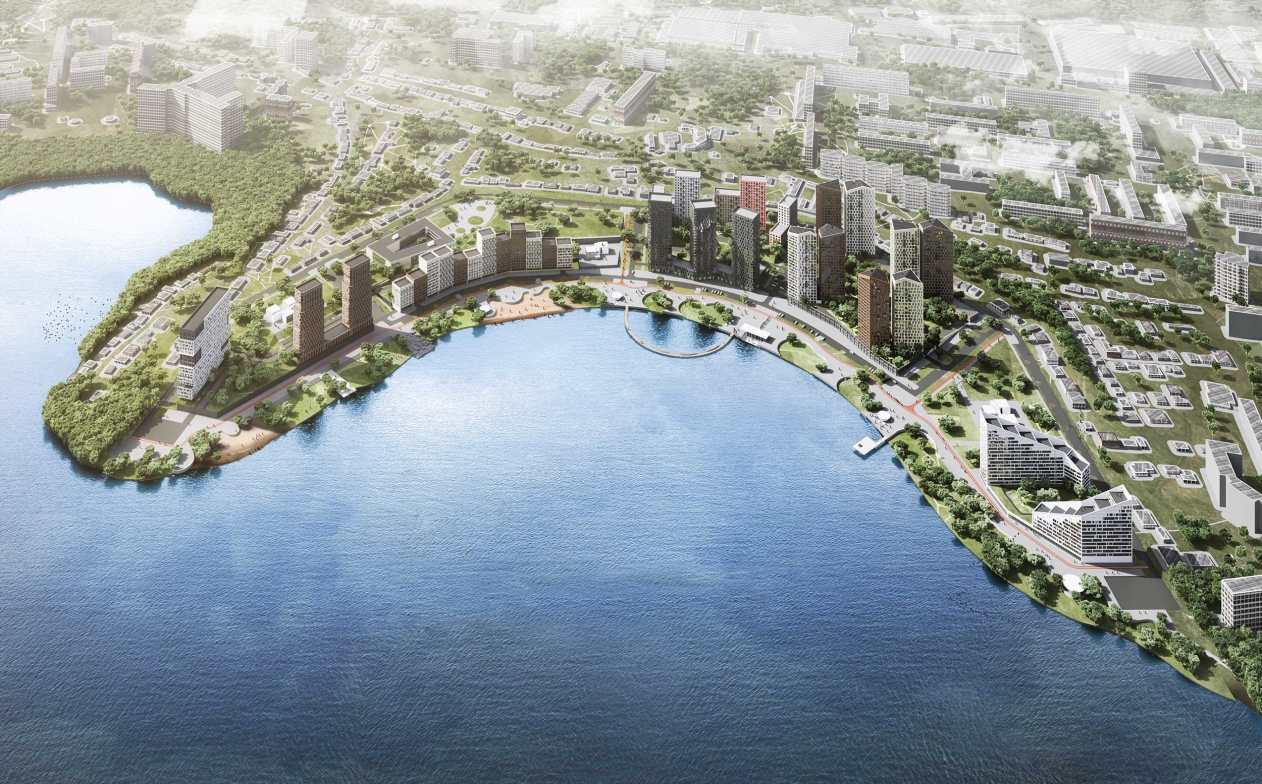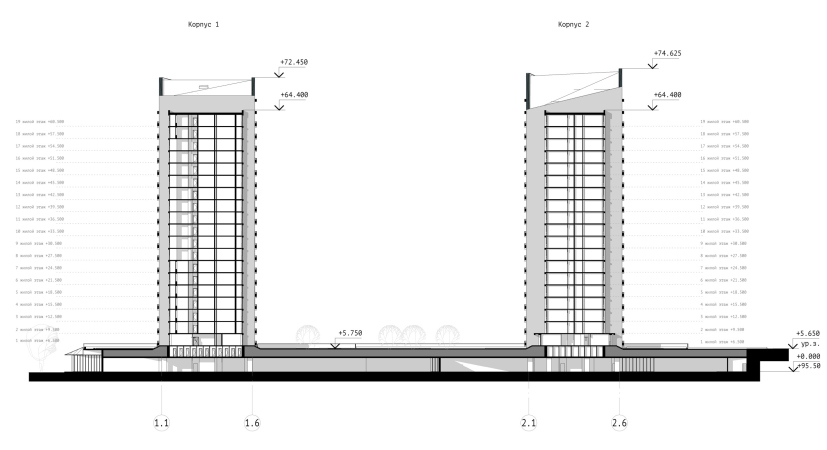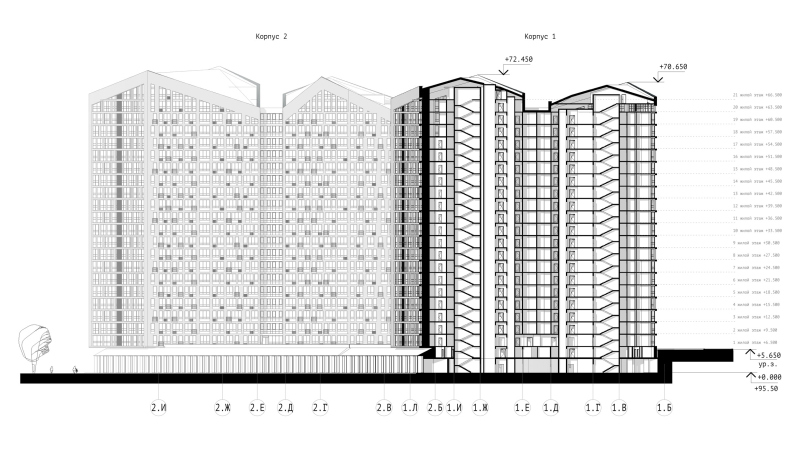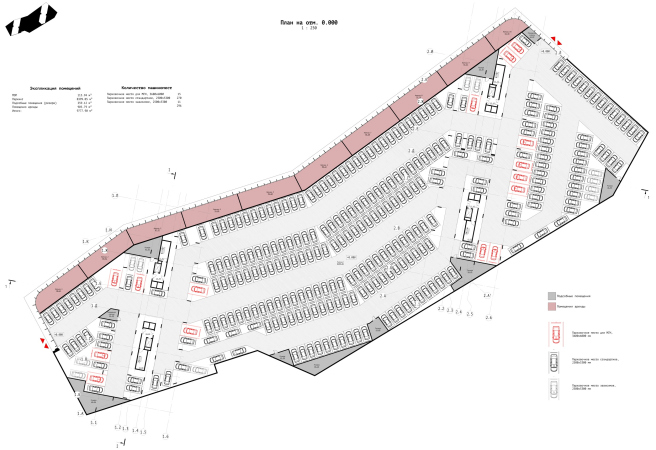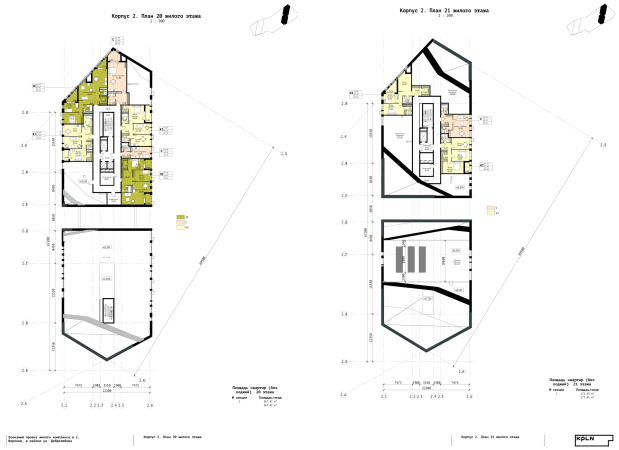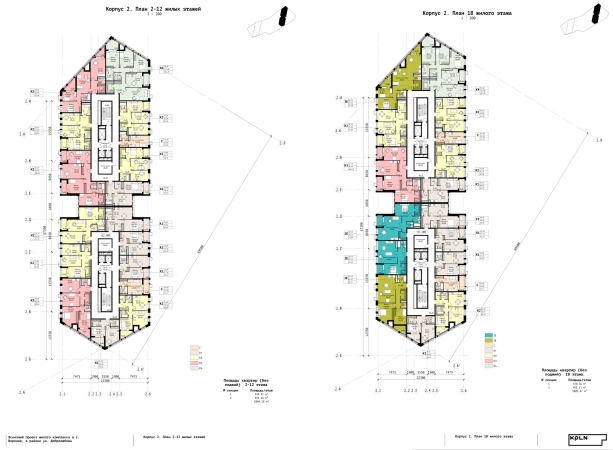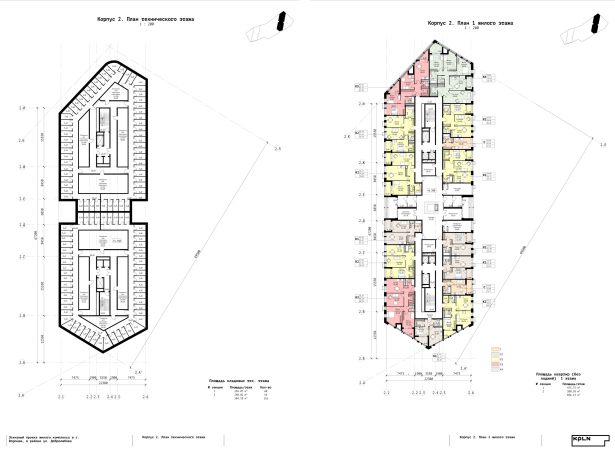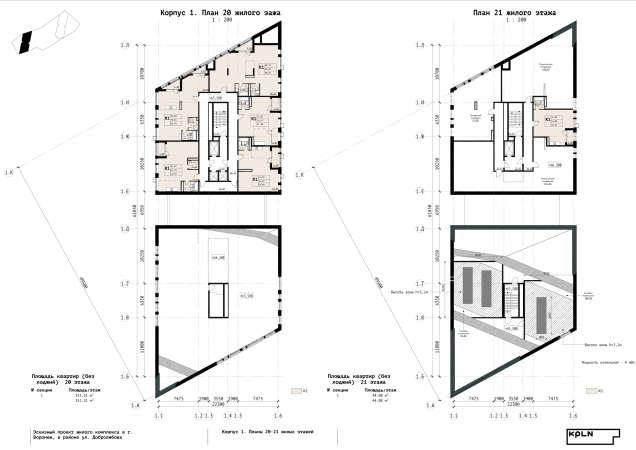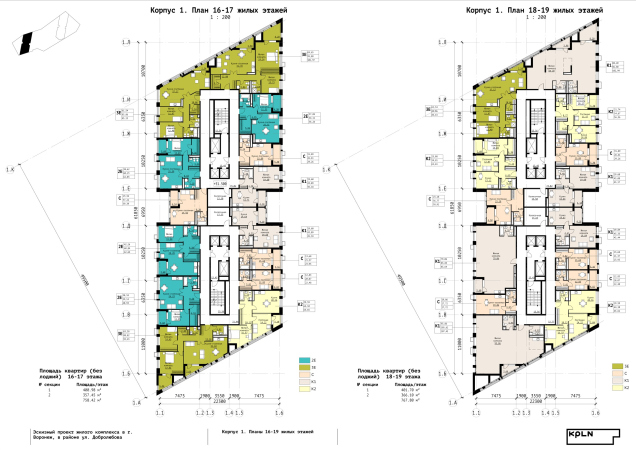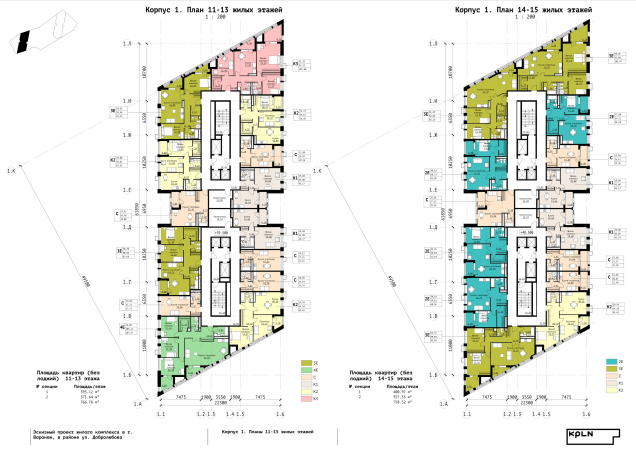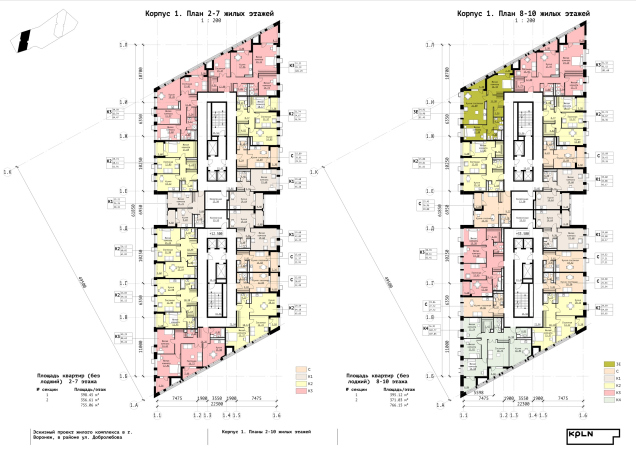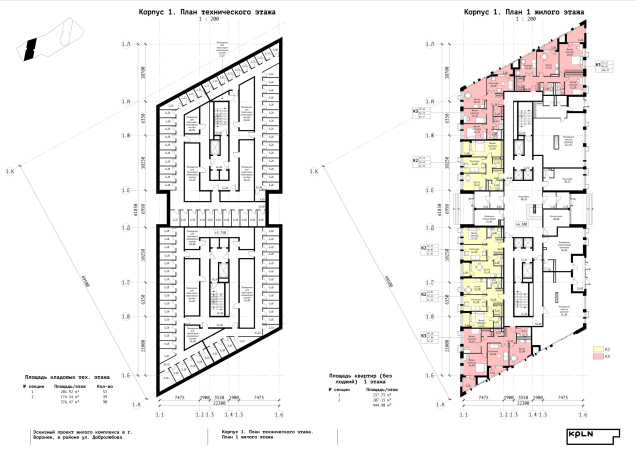The silhouette of the complex, designed by KPLN architects, unlike the “micro-district” that is being built nearby, is anything but “standard”. It puts one in the mind of New York, or Chicago, or, most likely, Dubai, yet not in a straightforward way – rather, it explores the very idea of a textbook example of towers by the water. It barely marks the recognizable archetypes without putting too much focus on them: here is an Art Deco Chicago couple, here is a modernist slab with dark spots that makes one think about Rotterdam; here is a string of sections of different height and colors, treated as towers that got “stuck” together, and here are towers that are sharpened as giant pencils, and here are again three “Wright” parallelepiped skyscrapers, yet black and slender, and here is a “mirror” couple of two triangular “sail” buildings.
“Zurbagan” housing complex. Concept of territory development in Voronezh, 2018-2020
Copyright: © Architectural Bureau KPLN
Each of the themes brings in its own color, emotion and association-wise, setting the change of impressions and ideas, yet in a very general way, not the way it is done in Las Vegas, but as a set of symbols that make you compare what you see with some high-profile architectural projects – and it yields something like an ABC of town planning images, given to us in sensations.
The “associatively sharpened” towers are placed along the bank; the city blocks are grouped a little bit further away from the water, behind the Dobrolyubova Street, “on the continent” – these are further development plans. “The central blocks of this housing construction, due to the height difference of the territory, are fundamentally divided into two levels: the upper one that faces the embankment and the lower one facing the Dobrolyubova Street” – Sergey Nikeshkin specifies.
The model. “Zurbagan” housing complex. Concept of territory development in Voronezh, 2018-2020
Copyright: © Architectural Bureau KPLN
All the houses rest on podiums, which essentially arrange them into groups. Using the height difference of the river bank – it is about 10 meters here – KPLN architects arrange the podiums along the river bank in such a way that from the outside they are sunk into the hill, which presents the main space for the underground parking garages, while the outside contour, facing the water, is occupied by local businesses – cafes, stores, and other rentable premises, which form a waterfront filled with city functions.
The roofs of the podiums will have private yards on them, and one will be able to enter these yards from the Dobrolyubova Street on the ground level, and, taking a few steps forward, one will find themselves one story higher than the waterfront.
Due to the fact that the construction front is not continuous, from the city side it is also accessed by driveways; there is also a street that runs in front of the houses, yet the pedestrian spaces are quite large, and make it possible to place enough tables and cafe umbrellas before the shop windows.
“Zurbagan” housing project. Concept for Voronezh, 2018
Copyright: © Architectural Bureau KPLN
There is also enough room for trees and lawns, while the paving pattern is designed in such a way that it is generally of the “city” type and descends to the water in a stone slice, like Venetian waterfronts do, i.e. on a rather high level – yet at some places it gets broken, encircling the islets of nature: for the sandy beaches – there are a few of them here – and for the existing trees that the architects tried to preserve during construction.
“Zurbagan” housing complex. Concept of territory development in Voronezh, 2018-2020
Copyright: © Architectural Bureau KPLN
From the waterfront, it’s the same picture as with the silhouette of the houses – typologically, it is a compound structure; it does not feature a single main face, quite the contrary, walking around the complex, you may find yourself sometimes on one level and then on another, sometimes watching the river from a stone elevation, or go down to the green bank under a willow or go barefoot through the sand toward the water’s edge.
“Zurbagan” housing complex. Concept of territory development in Voronezh, 2018-2020
Copyright: © Architectural Bureau KPLN
The deep bends of the stone part of the paving include the passageways from the “upper” embankment to the “lower” one; sometimes their steps become an amphitheater overlooking the river, gazing west, so people will have an opportunity to admire sunsets here. Oh, and by the way, the river panorama, with its romantic “sunset” factor was by no means neglected by the architects – they designed more windows overlooking the river, and even drew on the 3D simulations, in addition to the inside apartment light, the extra ambient orange light from the sunsets, which provide a very romantic “backlight”.
“Zurbagan” housing complex. Concept of territory development in Voronezh, 2018-2020
Copyright: © Architectural Bureau KPLN
The other benches on the wavy edge of the waterfront look in the opposite direction, i.e. towards the city promenade before the houses. As a result, a winding (as opposed to straight) line of the stone embankment not just makes it possible to integrate natural elements into it but also helps to ensure a kaleidoscope of impressions.
“Zurbagan” housing complex. Concept of territory development in Voronezh, 2018-2020
Copyright: © Architectural Bureau KPLN
Thus, the interaction with water here is not only contemplative; one can also come up closer by different routes, not just going to the beach. The central part will feature the main public descent to the water with stairs on both sides, and a couple of piers below protruding into the water. There are also plans for building a quay. In addition, the architects proposed a semicircular boardwalk for taking walks directly above the water.
“Zurbagan” housing complex. Concept of territory development in Voronezh, 2018-2020
Copyright: © Architectural Bureau KPLN
“Zurbagan” housing complex. Concept of territory development in Voronezh, 2018-2020
Copyright: © Architectural Bureau KPLN
“Zurbagan” housing complex. Concept of territory development in Voronezh, 2018-2020
Copyright: © Architectural Bureau KPLN
Getting back to the architecture of the houses proposed by KPLN – it is designed as being modern and diverse, the term “modern” meaning here not just the laconic character of straight lines and the proverbial absence of stylization, but also elements of a more relevant approach that takes into consideration the fact that we as humans strive for recognizable viewing angles, rich textures, and visual comfort. This meaning: light and dark volumes alternate, often in pairs, even though it is not always the case. For decorating the volumes that respond in “conservative” pitched roofs to their central location in the complex, the architects proposed brick of different tones; for the houses on the edges of the territory – fiber cement, which augmented the string of images with yet another narrative: the difference between the center and the periphery.
The facades. View from the embankment. “Zurbagan” housing complex. Concept of territory development in Voronezh, 2018-2020
Copyright: © Architectural Bureau KPLN
As for the facades, they are composed of slender piers with an alternating rhythm, supported by the composition of the grilles of the air conditioning units; the recessed balconies are set deep inside, even though you at times go see an occasional bay window. The height of the windows is visually enlarged by dark fills – what it ends up looking is a regular, even if sometimes “undulating” grid, sometimes sparser, and sometimes denser at the corners; the houses are semitransparent in a modern way, yet without the overused vertical window pairs: the grid correspond to the floor division at all places.
“Zurbagan” housing complex. Concept of territory development in Voronezh, 2018-2020
Copyright: © Architectural Bureau KPLN
“Zurbagan” housing complex. Concept of territory development in Voronezh, 2018-2020
Copyright: © Architectural Bureau KPLN
All this enormous diversity is meant to ultimately create a magnificent silhouette of the complex seen from the water area – from the side of the historical Voronezh it must look dramatic, and by no means monotonous, which is ensured by a varying rhythm of the gaps between the volumes and alternating contour solutions. The panorama unfolds before the eyes of the observer a certain narrative, a string of stories, readable from afar. And there is also a temptation to add: unlike the nearby prefab houses, new and old alike.
Panorama from the opposite shore of the lake. “Zurbagan” housing complex. Concept of territory development in Voronezh, 2018-2020
Copyright: © Architectural Bureau KPLN
As for the apartment selection of the complex, we can only consider two examples from the central part – the double-section houses, treated from the outside as pairs of towers with a pitched roof.
The first floors include public spaces for the residents of the complex, commercial rentable premises, and apartments too, while the technical floors combine mechanical rooms and variously configured storage rooms for the residents, implementing one of the progressive trends of today. The types of apartments range from studios to three-room ones, most of the plans including a kitchen / living room, yet there are also separate versions for the traditionalists. There are also options with changeable plans. Many of the apartments, starting from the double-room ones, feature two bathrooms.
In a word, this is a grand-scale concept of construction and development of the area at the edge of Voronezh, solved in the vein of modern trends of focusing on landscaping the public territories, and drawn with keen attention to detail, as well as distributing the masses in the far-end perspective. Towering above the water of the Voronezh reservoir, locally called “the sea”, these new houses do indeed take on the romantic features of a city of towers and sails: as if some universal theater of “city by the water” images got arrested in midair just ready to be implemented.

